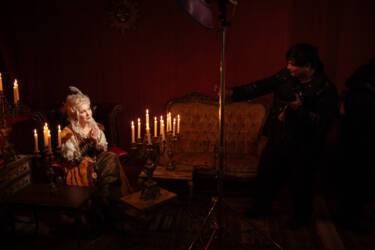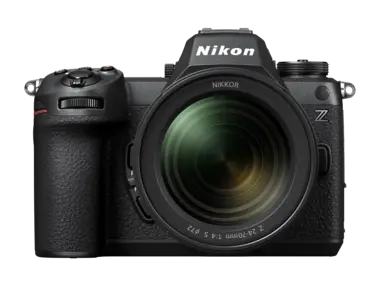Light, texture, drama: Lyonel Stief’s masterclass with the NIKKOR Z 35mm f/1.2 S

Tasked with using only one lens, Lyonel Stief reveals how the new NIKKOR Z 35mm f/1.2 S unlocks texture-rich portraits with depth, drama and detail
From forest nymphs to ice queens, pirates to phantoms and every sci-fi fantasy and fairy-tale icon in between, Lyonel Stief captures dynamic portraits so textured they seem to thrum with a tangible presence. Drawing on his background as both a choreographer and a media designer, the German-based creative treats photography as theatre, with each photo session his stage, where costume, expression, music, colour and movement converge. For Lyonel, portraiture is not about snapping a fleeting moment, it’s about staging one. It’s this ethos that made him the perfect Nikon Creator to equip with the new NIKKOR Z 35mm f/1.2 S – a lens that’s not only ideal for spotlighting texture and pattern, but one that also excels at rendering lifelike nuance.

“Previously my studio’s prop room, I painted this room red to create a space for historical-style sets, with chandeliers and so on. So my inspiration for using the new lens was more about the room itself than the model.”
Building an atmosphere
“I don’t capture moments, I create them,” Lyonel begins, as he introduces a scene that appears to be plucked from a grand portrait of centuries past. His model, with her towering white wig, pearl-studded velvet gown and Medici ruff, hints at something clandestine in her expression as she sits nestled in an intimate chamber draped in darkness and burgundy fabrics, seemingly lit only by clusters of flickering candelabras. “First I think about the subject – who or what is the model going to be today?” explains Lyonel. “Then, like a second protagonist, I choose the light. The atmosphere is built with light. Light is the medium we use to connect with our surroundings. When the light changes, it places us in a completely different context. It defines the mood of the whole piece, so it’s important to get that right.”
Painting with light
While a painter prefers to begin with a blank white canvas, Lyonel says his starting point is always darkness. “I ask myself, ‘What do I want to be visible in the face? How hard or soft should my shadows be?’” he says. “Typically, I prefer images to be on the darker side, and I love defined shadows. Then once I know what light I want, I’ll add it step by step.”
For this project, Lyonel was intent on using candlelight to create the atmosphere he’d envisioned. But not all is as it seems. “The thing with candlelight is the flame’s natural spill and colour are often too weak to notice,” he explains. “So I placed an orange LED behind the candle to fake the warm glow it would cast, making it look more realistic on the face. And because candlelight alone isn’t a strong enough light source, I added a very weak key light; a continuous 40cm beauty dish with a grid, set to just one or two per cent. That way, the light didn’t spread, but stayed very defined, emphasising the face and part of the upper body without lighting the whole room.”


Capturing texture
When it comes to revealing texture and detail, Lyonel points out the role of lighting, “It’s important to remember that defined light sources that are harder will emphasise textures more than, say, big soft light sources,” he says. “Also, you must put the key light not in front of the subject, but a little to the side, maybe 30-45°, to create three-dimensionality. If you paint a ball from the side and add shadow, the shadow gives the ball context from its environment and the object itself, and that’s what makes the texture visible.”
35mm, the perfect focal length
Painted a deep, decadent red, the setting for this project was Lyonel’s former prop room at his Wiesbaden studio near Frankfurt. The intimate space proved perfect not only for his pseudo-historical set-ups such as this one, but also for testing the full potential of the NIKKOR Z 35mm f/1.2 S. Working at f/1.2, Lyonel says he could draw focus to his model, separating her from the surroundings yet still letting the richness of the environment come through: “I was so excited to try the new NIKKOR Z 35mm f/1.2 S for this photo session because it’s a focal length that works perfectly for me and my style. It’s my go-to for environmental portraits like this, as it’s great for capturing interaction and giving context with the environment. I would not use 35mm for full-length images with fabrics flying around the model in front of a simple backdrop, and I do not use it for close-ups because the perspective can be unflattering, but it is perfect for half-body images, from the belly up, or sometimes full length if the model is sitting.”


Making the most of f/1.2
Beyond subject separation, Lyonel says the f/1.2 aperture opened up more creative options in low light, allowing him to work with sources such as candlelight that would otherwise be impossible. “Normally, in low light you need to go to a very high ISO, but here I could keep the ISO relatively low, around ISO 160 at 1/125 sec,” he explains. “If I wanted more sharpness, I could stop down, but having the option to open up was great for that light, and in a small space the fall-off makes the room look bigger. You get a look similar to a longer focal length like an 85mm, even though you are closer. Also the build of the lens is very solid. You can feel the quality just by holding it.”


Directing for detail
Working with such a defined lighting set-up, Lyonel explains that precision becomes everything, both in how he lights and how he directs his model. “With a complex lighting set-up like this, where the model can’t move much to the left or right, all my directing of her posing had to be really precise because the light is so exact,” he says. “That’s very different from working with, say, a huge softbox or natural light, where you can move around freely. Luckily, with this lens at f/1.2, you still have a relatively high depth of field on the plane of focus itself, so that helps me to have more in focus than just the eyes, for example.”
The key here, Lyonel says, is to start big and work step by step into the smaller details. “I try to keep my subjects relatively parallel to the camera, so I get more details not only on the face, but also in the upper body,” he explains. “I choose the focus point manually out of habit, and first I’ll start with how she sits and where she sits. Then I’ll refine the upper body, hands, head and shoulders. After that, I focus on the nose and the head tilt. Especially the head tilt! If you work with small light sources like a beauty dish, it changes everything. For me, the point of the nose and the tilt of the head are the two most important axes in portraiture. Last, I focus on the eyes and lips.”

Lyonel’s top tips for capturing dramatic, texture-rich portraits
- “Find a material that inspires you. It could be abstract materials around a face, an amazing dress, or even the décor of a room. Then choose the right framing so the material is emphasised. So for this dress a half-body capture with a 35mm was perfect, because if I was to go further out you wouldn’t see the details; too close and they wouldn’t be part of the story. Generally speaking, go closer if you have really detailed fabric, likewise for flat, plain or thin fabric you can go wider.”
- “A great and simple way to show textured fabric is to capture a lay flat portrait. Lay the model down, drape the material around them and take the image from above at 90°. Gravity becomes your friend and you do not need lots of complex supports.”
- “Choose an environment that gives you some depth so the classic 35mm focal length look works. You can do this just by giving your model something to interact with such as a chair, a table or a prop.”
- “Set up all your equipment and make your technical choices before the model arrives – the location, the lighting, the camera settings. When the model arrives, take a test photo, check your settings, and now you’re free to focus on the posing. Start with big pose elements, then refine shoulders, head angle and finally eyes and lips. Remember, a head tilt changes everything!”
- “To emphasises texture, use a harder key light, rather than a soft source. Place the key slightly to the side, about 30-45°, to get a more three-dimensional look.”
Discover the NIKKOR Z 35mm f/1.2 S
Featured products
Uncover NIKKOR lenses

Unlock greater creativity









